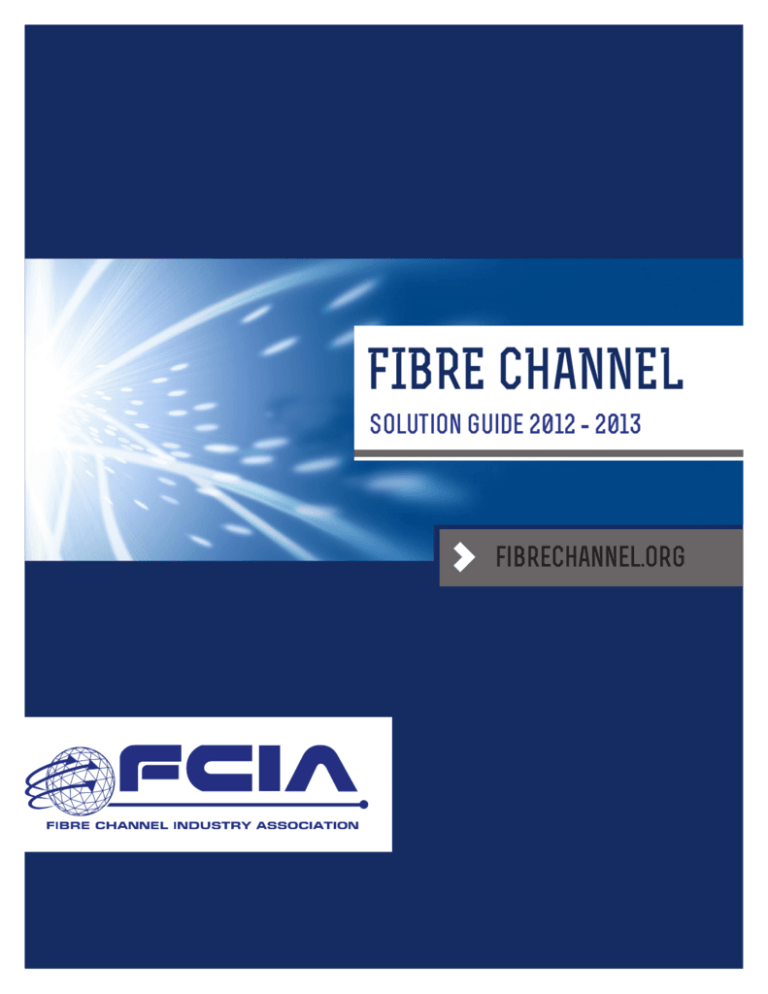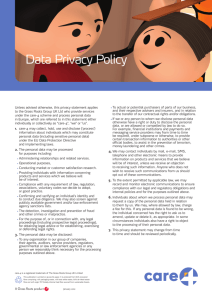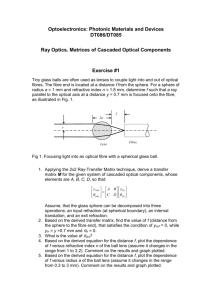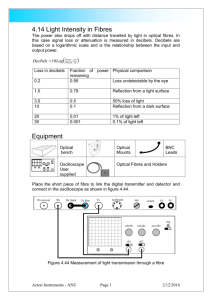
FIBRE CHANNEL
Solution guide 2012 - 2013
fibrechannel.org
Fibre channel
and FCoE
Powering the next generation
Private, public, and hybrid
Cloud storage networks
About the FCIA
The Fibre Channel Industry Association (FCIA) is a non-profit
international organization whose sole purpose is to be the
independent technology and marketing voice of the Fibre Channel
industry.
We are committed to helping member organizations promote and
position Fibre Channel, and to providing a focal point for Fibre
Channel information, standards advocacy, and education.
Today, Fibre Channel technology continues to be the data center
standard for storage area networks and enterprise storage, with more
than 80 percent market share.
contact the FCIA
For more information:
www.fibrechannel.org
info@fibrechannel.org
CONTENT
4 State of the fibre channel industry
6 speed and convergence: follow the FCIA Roadmap to success
9 16gfc deployments addresses data center challenges
13 40Gb FCoE: The Future of Hyper-Agility in the Data Center
16 Fibre channel connectivity
18 How Fibre channel plugfests help prepare products for market
STATE OF FIBRE CHANNEL INDUSTRY
This year, Fibre Channel has achieved a significant milestone. FCIA has
termed it 10-10-10 for 10 million Fibre Channel ports shipped, $10B
invested in Fibre Channel technology and 10 Exabytes (EB) of storage
shipped . In 2012, 10M Fibre Channel ports are expected to ship when
you combine adapter and switch ports[1], not even counting target ports
on storage arrays. Also, over $10B of Fibre Channel Enterprise Storage
Systems will be sold worldwide, representing 62% of all Storage Area
Network storage in the market[2]. The FCIA calculates that over $100B
has been invested in Fibre Channel over the last two decades. Finally, for
the first time ever, 10 EB of Fibre Channel storage capacity in external
enterprise storage systems will be shipped - representing 66% of the SAN
market[3]. So, 2012 is the year of 10-10-10 for Fibre Channel that shows
how Fibre Channel continues to flourish with the rest of the IT markets.
10 - 10 - 10
[1] Worldwide Storage Area Network Market – Fibre Channel Forecast, January 2012
[2] Worldwide External Enterprise Storage Systems Revenue by Topology, Installation,
and Protocol 2006-2015 ($B), IDC, 2011
[3] Worldwide External Enterprise Storage Systems Capacity Shipped by Topology,
Installation and Protocol 2006-2015 (PB), IDC, 2011
4
Today’s data explosion presents unprecedented challenges incorporating a wide range
of application requirements such as database, transaction processing, data warehousing,
imaging, integrated audio/video, real-time computing, and collaborative projects. For nearly
two decades, storage area networks (SANs) have become mainstays for companies looking
to increase storage utilization and manageability while reducing costs. SANs represent a
topology for connecting storage assets directly to the network and establishing a peer-topeer server/storage implementation and to solve multiple issues for enterprises with data
centers to remote offices.
As the volume and criticality of data grow, companies need efficient, scalable solutions for
making data available to servers, applications, and users across the enterprise. By providing a
network of storage resources to servers, Fibre Channel SANs uncouple storage from individual
platforms, allowing data transfer among all nodes on the storage network.
Fibre Channel is an ideal solution for IT professionals who need reliable, cost-effective
information storage and delivery at fast speeds. With development starting in 1988 and ANSI
standard approval in 1994, Fibre Channel is a mature, safe solution for 1GFC, 2GFC, 4GFC,
8GFC and 16GFC communications, with 32GFC industry standards development complete this
year, 2012, and 10GFCoE, 40GFCoE and 100GFCoE providing an ideal solution for fast, reliable
mission-critical information storage and retrieval for today’s data centers.
10 MILLION FIBRE CHANNEL PORTS
$10B INVESTED IN FIBRE CHANNEL TECHNOLOGY
10 EXABYTES (EB) OF STORAGE SHIPPED
If we look at what is coming in 2012 (Virtualization, Big Data and Analysis, Cloud storage
networks, social media, archive, disaster recovery, personal, professional and corporate
media, records, entertainment, and in general e-accessibility to most all things, IO bandwidth
requirements are greatly increasing and going nowhere but up. IO bandwidth will be expected
to handle more and more traffic, be it the same dedicated traffic types on separate physical
networks, or multiple converged data traffic types onto a single network.
5
SPEED AND CONVERGENCE
FOLLOWING THE FCIA ROADMAP TO SUCCESS!
By: Skip Jones - Chairman, FCIA
The heart and soul of any technology, and the industry association that stewards the technology, is its technology roadmap. Just
like the term suggests, a roadmap shows the history of a technology. It is also a guide to where it is going and when it is going to
get there. The three primary audiences for a technology roadmap are the user base that deploys the technology, the development,
manufacturing and distribution base that supplies the technology, and the industry standards bodies that develop standards for
the technology.
An accurate roadmap provides a reliable guide for suppliers to plan their product development and release cycles based upon the
features and timing of the technology migration for the future.
A consistently trustworthy roadmap provides the user with a planning document. Additionally, the roadmap provides the user with
confidence that their investments in the technology will be preserved into the foreseeable future. The roadmap shows that the
technology has legs to run with and thereby ensures their investments today are future-proofed for tomorrow.
A dependable and responsible roadmap provides standards bodies a planning cookbook by which they can initiate and complete
standards within the timeframe defined by the roadmap. The roadmap also directs suppliers on when to begin product development
using with said technology. The supplier’s development efforts are based upon open standards that are technically complete. Some
technology developments are required building blocks for further product development. For example, lasers in optical modules
need to be developed before the modules can be developed that will eventually be used in a switch or host bus adapter. With a solid
roadmap and standards, multiple companies can develop products in parallel that will eventually interoperate when they reach the
market.
So how does a technology roadmap become a responsible, reliable, trustworthy and consistently accurate planning document? The
short answer is that it takes time and commitment. It takes time for the roadmap to have a sufficiently deep history that has year-in
and year-out kept its promise to become credible. It must be a stable and consistent document that did not frequently change and
reset expectations in the industry. A changing roadmap causes confusion and could cause faulty planning by users and suppliers
based upon an erroneous, ever-changing inaccurate roadmap. In order to avoid loss of credibility and trust from standards creators,
technology suppliers and end users, it simply must have a rich history of being solidly accurate in its past forecasts.
One of the best industry examples of a roadmap that meets this proven reliable, trustworthy criterion is the FCIA roadmap. Since
1997, the FCIA roadmap has been spot-on with its mapping of Fibre Channel speeds. In addition to the Fibre Channel speeds, the
FCIA has also mapped the timeline and speed migration for FCoE. FCIA success in delivering 15 years of accurate roadmaps come
from the seriousness FCIA takes in this huge responsibility and obligation to the industry.
6
fibre channel roadmap
• “FC” used throughout all applications for Fibre
Channel infrastructure and devices, including
edge and ISL interconnects. Each speed maintains
backward compatibility at least two previous
generations (I.e., 8GFC backward compatible to
4GFC and 2GFC.
• †Line Rate: All “FC” speeds are single-lane serial
stream
• ‡Dates: Future dates estimated
Throughput
(MBps)
Line Rate
(GBaud)†
T11 Spec Technically
Completed (Year) ‡
Market
Availability
(Year) ‡
1GFC
200
1.0625
1996
1997
2GFC
400
2.125
2000
2001
4GFC
800
4.25
2003
2005
8GFC
1600
8.5
2006
2008
16GFC
3200
14.025
2009
2011
32GFC
6400
28.05
2012
2014
64GFC
12800
TBD
2015
Market Demand
128GFC
25600
TBD
2018
Market Demand
256GFC
51200
TBD
2021
Market Demand
512GFC
102400
TBD
2024
Market Demand
Product
Naming
FCIA has a Roadmap Committee that is closely associated with INCITS T11.2 Task Group, the standards body that defines Fibre
Channel speeds. Since FCIA meets at the T11 meetings, and its roadmap committee includes many of the key T11.2 standards
engineers as well as key Fibre Channel supplier corporate and technical marketing experts, the resulting roadmap is the refined
product of an intense iterative process that pinpoints highly attractive market propositions balanced with sound engineering
feasibility. The end result is an official FCIA roadmap and set of MRDs (Marketing Requirement Documents) that becomes T11.2’s
map of speeds and timelines. The MRDs define sets of features and benefits that are both feasible within the roadmap timelines,
and they also result in actual products delivered in the prescribed timeframe that realize massive market success.
T11.2, like any standards body, is allergic to wasting time developing standards that never see the light of day in successful markets.
That is one key reason that FCIA’s roadmap, different from other industry roadmaps, takes great pains in accurately defining when a
technically stable standards document is required to enable a specific speed migration and products based upon that speed.
isl (inter-switch link) roadmap
• ISLs are used for non-edge, core connections,
and other high speed applications demanding
maximum bandwidth. Except for 100GFC (which
follow Ethernet)
• †Equivalent Line Rate: Rates listed are
equivalent data rates for serial stream
methodologies.
• ‡ Some solutions are Pre-Standard Solutions:
There are several methods used in the industry
to aggregate and/or “trunk” 2 or more ports
and/or data stream lines to achieve the core
bandwidth necessary for the application.
Some solutions follow Ethernet standards and
compatibility guidelines. Refer to the FCoE
roadmap for 40GFCoE and 100GFCoE.
Throughput
(MBps)
Equivalent
Line Rate
(GBaud)†
T11 Spec Technically
Completed (Year) ‡
Market
Availability
(Year) ‡
10GFC
2400
10.52
2003
2004
20GFC
4800
21.04
TBD
2008
9600
41.225
2010
24000
103.125
2010
96000
TBD
TBD
240000
TBD
TBD
Product
Naming
40GFC/
FCoE
100GFC/
FCoE
400GFC/
FCoE
1TFC/
FCoE
Market
Demand
Market
Demand
Market
Demand
Market
Demand
7
FOLLOWING THE FCIA ROADMAP TO SUCCESS!
FCIA’s process for roadmap development has over the years earned the trust from T11.2 to the point that its MRDs and resulting
roadmap become INCITS documents embedded in the standards development process. The roadmap ensures that what goes down
on paper for official standards are within its guidelines.
This successful FCIA/T11 process of roadmap development and relentless execution results in reliable, relevant standards. The
resulting standards are stable and ready in time for suppliers to begin their development. They are standards that meet feature/
benefit criteria and guarantee functionality, cost, compatibility, power, length, and other components for a successful market. The
user benefits by having a wide selection of products based upon open standards in a timeframe that meets the user’s demand.
FCIA’s Roadmap, version V14, is the latest descendent of a long successful history of the FCIA roadmap and can be found at: www.
fibrechannel.org/fibre-channel-roadmaps.html It maps the doubling of Fibre Channel speeds from 1GFC (Gigabits per second Fibre
Channel), 2GFC, 4GFC all the way out to 512GFC in factors of 2 GFC for edge connectivity. Each doubling of speed has taken about
3 years to complete and the 32GFC standard is expected to be stable in 2012. It also maps FC and FCoE ISL’s (Inter-Switch Links) out
to 1TFC (1 Terabit/s Fibre Channel) and 1TFCoE (1Terabit/s Fibre Channel over Ethernet). The V14 Roadmap also pinpoints standard
stability and general market availability for 16GFC and 32GFC edge connectivity (16GFC in 2011 and 32GFC in 2014, respectively).
This roadmap shows the long legs that Fibre Channel has going into the future.
Other important elements defined in the roadmap include backward compatibility. For instance, just like 1GFC, 2GFC, 4GFC, and
8GFC edge connectivity, 16GFC and 32GFC are required to be backward compatible at least two generation. These speeds are autonegotiated with no user intervention required, - i.e., 16GFC will automatically run at 4GFC and 8GFC, whilst 32GFC will automatically
run at 8GFC and 16GFC. This important level of backward compatibility has been and will continue to be a major benefit in Fibre
Channels continued success.
FCoE Roadmap
• Fibre Channel over Ethernet tunnels FC
through Ethernet. For compatibility all
10GFCoE FCFs and CNAs are expected to use
SFP+ devices, allowing the use of all standard
and non standard optical technologies and
additionally allowing the use of direct connect
cables using the SFP+ electrical interface. FCoE
ports otherwise follow Ethernet standards and
compatibility guidelines.
• †Line Rate: All “FC” speeds are single-lane
serial stream
• ‡Dates: Future dates estimated
• *It is expected that 40GFCoE and 100GFCoE
based on 2010 standards will be used
exclusively for Inter-Switch Link cores, thereby
maintaining 10GFCoE as the predominant FCoE
edge connection
8
Throughput
(MBps)
Equivalent
Line Rate
(GBaud)†
T11 Spec Technically
Completed (Year) ‡
Market
Availability
(Year) ‡
10GFCoE
2400
10.315
2008
2009
40GFCoE
9600
41.225
2010*
240000
103.125
2010*
Product
Naming
100GFCoE
Market
Demand
Market
Demand
16GFC DEPLOYMENT
ADDRESSES DATA CENTER CHALLENGES
16 Gigabit per second Fibre Channel (16GFC) products were
released in 2011 and are being widely deployed.
By: Scott Kipp, Senior Technologist, Brocade
Rupin Mohan, Senior Manager Strategy & Product Planning, Hewlett Packward and Member of FCIA Board of Directors
Introduction
The T11 technical committee that defines Fibre Channel interfaces has completed three standards related to 16GFC. The Fibre
Channel industry is doubling the data throughput of 8GFC links from 800 Megabytes/second (MBps) to 1,600 MBps with 16GFC.
16GFC is the latest evolutionary step in Storage Area Networks (SANs) where large amounts of data are exchanged and high
performance is a necessity. From Host Bus Adapters (HBA) to switches, 16GFC will enable higher performance with lower power
consumption per bit. 16GFC delivers the performance required by today’s leading applications.
16GFC is backward-compatible with 3 previous generations of Fibre channel – 2GFC, 4GFC and 8GFC so that customers can
leverage their existing Fibre Channel investments in their data center. Using the same Small Form Factor Pluggable + (SFP+)
interface, 16GFC enables the use of the same cabling infrastructure that they have been deploying for years.
The benefits of any faster technology are easy to see. Data transfers are faster, fewer links are needed to accomplish the same
task, fewer devices need to be managed and less power is consumed when 16GFC is used instead of 8GFC or 4GFC. Several
technology advances in the data center are pushing up bandwidth demands in SANs that include application growth, server
virtualization, multi-core processors, PCI Express 3.0, increased memory and solid state disks. 16GFC is keeping pace with other
technology advances in the data center.
16GFC should be applied where high bandwidth is needed. Applications where bandwidth demands are high include server
virtualization, storage array migration, disaster recovery, virtual desktop infrastructure (VDI) and inter-switch links (ISLs). The
first place that new speeds are usually needed in SANs is in ISLs in the core of the network and between data centers. When
large blocks of data need to be transferred between arrays or sites, a faster link can accomplish the same job in less time. 16GFC
is designed to assist users in transferring large amounts of data and decreasing the number of links in the data center.
Overview of 16GFC
16GFC has considerable technical improvements from the previous Fibre Channel speeds that include using 64b/66b encoding,
transmitter training and linear variants as outlined in Table 1. 16GFC doubles the throughput of 8GFC to 1,600 MBps but uses
64b/66b encoding to increase the efficiency of the link. 16GFC links also use retimers in the optical modules to improve link
performance characteristics. 16GFC also uses electronic dispersion compensation (EDC) and transmitter training to improve
backplane links. The combination of these technologies enables 16GFC to provide the highest throughput density in the
industry.
Speed
Name
Throughput
(MBps)
Line Rate
(GBaud)
Encoding
Retimers in
the module
Transmitter
Training
1GFC
100
1.0625
8b/10b
No
No
2GFC
200
2.125
8b/10b
No
No
4GFC
400
4.25
8b/10b
No
No
8GFC
800
8.5
8b/10b
No
No
10GFC
1200
10.53
64b/66b
Yes
No
16GFC
1600
14.025
64b/66b
Yes
Yes
Table 1: Fibre Channel Speed Characteristics
9
While 16GFC doubles the throughput of 8GFC to 1600 MBps, the line rate of the signals only increases to 14.025 Gbps because
of a more efficient encoding scheme. Like 10GFC and 10 Gigabit Ethernet, 16GFC uses 64b/66b encoding that is 97% efficient
compared to 8b/10b encoding that is only 80% efficient. If 8b/10b encoding was used for 16GFC, the line rate would have
been 17 Gbps and the quality of links would be a significant challenge because of higher distortion and attenuation at higher
speeds. By using 64b/66b encoding, almost 3 Gbps of bandwidth was dropped off the line rate so that the links could run over
100 meters of optical multimode 3 (OM3) fiber. By using 64b/66b encoding, 16GFC improves the performance of the link with
minimal increase in cost.
To remain backward compatible with previous Fibre
Channel speeds, Fibre Channel application specific
integrated circuit (ASIC) must support 8b/10b
encoders and 64b/66b encoders. As seen in Figure
1, a Fibre Channel ASIC that is connected to an SFP+
module has a coupler that connects to each encoder.
The Speed Dependent Switch directs the data stream
towards the appropriate encoder depending on the
selected speed. During speed negotiation, the two
ends of the link determine the highest supported
speed that both ports support.
Fibre Channel ASIC
For 16GFC
64b/66b
Encoder
Upper Level
Processing
+ Buffers
Speed
Dependent
Switch
Coupler
8b/10b
Encoder
SFP+
For 2/4/8GFC
Figure 1: Dual Codecs
The second technique that 16GFC uses to improve
link performance is the use of retimers or Clock and
Data Recovery (CDR) circuitry in the SFP+ modules. The most significant challenge of standardizing a high-speed serial link is
developing a link budget that manages the jitter of a link. Jitter is the variation in the bit width of a signal due to various factors,
and retimers eliminate the majority of the jitter in a link. By placing a retimer in the optical modules, the link characteristics are
improved so that the links can be extended for optical fiber distances of 100 meters on optical multimode 3 (OM3) fiber. The
cost and size of retimers has decreased significantly so that they can be integrated into the modules for minimal cost.
The 16GFC multimode links were designed to meet the distance requirements of the majority of data centers. Table 2 shows
the supported link distances at multiple speeds over multimode and single-mode fiber. 16GFC was optimized for OM3 fiber and
supports 100 meters. With the standardization of OM4 fiber, Fibre Channel has standardized the supported link distances over
OM4 fiber and 16GFC can support 125 meters. If a 16GFC link needs to go farther than these distances, a single-mode link can
be used that supports distances up to 10 kilometers. This wide range of supported link distances enables 16GFC to work in a
wide range of applications.
Multimode OM1
Link Distance
Multimode OM2
Link Distance
Multimode OM3
Link Distance
Multimode OM4
Link Distance
Single-mode OS1
Link Distance
62.5 um core and
200 MHZ*km
50 um core and 500
MHz*km
50um core and
2000 MHz*km
50um core and
4700 MHz*km
9um core and ~infinite MHz*km
1GFC
300
500
860
*
10,000
2GFC
150
300
500
*
10,000
4GFC
50
150
380
400
10,000
8GFC
21
50
150
190
10,000
10GFC
33
82
300
*
10,000
16GFC
15
35
100
125
10,000
Speed
Name
* The link distance on OM4 fiber has not been defined for these speeds.
Table 2: Link Distance with Speed and Fiber Type (meters)
10
Another important feature of 16GFC is that it uses transmitter training for backplane links. Transmitter training is an interactive
process between the electrical transmitter and receiver that tune lanes for optimal performance. 16GFC references the IEEE
standards for 10GBASE-KR, which is known as Backplane Ethernet, for the fundamental technology to increase lane performance.
The main difference between the two standards is that 16GFC backplanes run 40% faster than 10GBASE-KR backplanes for
increased performance.
The Benefits of Higher Speed
The benefits of faster tools are always the same – more work in less time. By doubling the speed, 16GFC reduces the time to transfer
data between two ports. When more work can be done by a server or storage device, fewer servers, HBAs, links and switches are
needed to accomplish the same task. The benefits of 16GFC add up and include:
•
Reduced number of links, HBAs and switch ports to do the same workload
•
Reduced power consumption per bit
•
Easier cable management
Reduced Number of Links
As with other speeds of Fibre Channel, the first application of new Fibre Channel speeds is on ISLs between switches. Large
fabrics are composed of many switches that are connected via multiple ISLs. Reduction of the number of ISLs between switches
is a key benefit of each higher speed. Brocade switches will continue to support trunking of up to 8 links of 16GFC to yield a
128GFC link between any two switches. These trunks can grow from 16GFC to 128GFC in 16G increments.
Figure 2 shows a simple comparison of the
number of links in an 8GFC fabric and a 16GFC
fabric. The higher speed links of 16GFC
eliminates tens or hundreds of ports from
a comparable 8GFC fabric. The real savings
occur when the number of HBAs, switches
and end devices can be decreased with the
higher performance of 16GFC. In the example
in Figure 2, a Top of Rack (ToR) switch needs
100 Gbps of bandwidth so the user needs
eight 16GFC ISLs instead of sixteen 8GFC ISLs.
Similar comparisons between 16GFC ISLs and
8GFC ISLs are given in the table in Figure 2 to
show how fewer ports and links are needed at
16GFC.
Core to Core
150 Gbps
ToR Switches
100Gbps
Blade Swithces
70Gbps
ISLs
from ToR
Switch to
Core
ISL from
Blade
Switch to
Core
Core to
Core
Total
ISLs
Total
Ports
8GFC Links
16GFC Links
16
8
20
5
24
12
50
25
100
50
Figure 2: Network Design Implications
Reduced Power Consumption per Bit
Besides the reduction in equipment that cuts power consumption dramatically, 16GFC also reduces the power required to transfer
bits on the link. When the cost of cabling and operating expenses (opex) such as electricity and cooling are considered, the total
cost of ownership (TCO) is often less when links are run at twice the speed. The goal of 16GFC designs is for a 16GFC port to
consume less power than two 8GFC links that deliver the same throughput. Initial estimates for power consumption show 16GFC
SFP+s consuming 0.75 Watts of power while 8GFC SFP+ consuming 0.5 Watts of power. These estimates show that a 16GFC link
will consume 25% less power than two 8GFC ports.
Easier Cable Management
If fewer links are needed, cable management becomes simpler. Managing cables behind a desktop or home entertainment center
are bad enough, but managing hundreds of cables from a single switch or bundles of cable from a server can be horrendous. The
reduction of cables aids in troubleshooting and recabling. The cost of cabling is significant and users can pay over $300/port in
structured cabling environments. Reducing the number of links by using fast 16GFC links aids cable management.
11
The Fibre Channel industry has teamed with cable management
companies to provide incredibly dense solutions for cable
management. To reduce the bulk of cables, multiple vendors offer
uniboot cables that combine two fibers into one cord and then
combining 12-fibers into one ribbon cable as shown in Figure 3.
The LC to MPO cable
harnesses reduce cable
bulk and utilize compact
fiber ribbons. The fiber
optics cable industry
also provides very dense
patch panels for MTP and
LC connectors - excellent
solutions for all varieties Figure 3: Uniboot LC to MTP Cable Harness
of cable management.
Summary of Benefits
The end result of 16GFC is that there are less links, less cables, less
ports and less power for the same performance. Figure 4 shows
the comparison of one 16GFC link to two 8GFC links. The largest
benefits of the 16GFC ports will be the fewer number of HBAs and
switch ports that are connected to these media.
Figure 4: Comparison of media
Summary
SPEED
WINS!
12
Speed wins! It’s not rocket science to understand that a link that is twice
as fast as a slower link can do more work. While many applications
won’t use the full extent of a 16GFC link yet, over the next few years,
traffic and applications will grow to fill the capacity of 16GFC. The
refresh cycle for networks is often longer than that of servers and
storage, so 16GFC will remain in the network for years. With more
virtual machines being added to a physical server, performance
levels can quickly escalate beyond the levels supported by 8GFC. To
future-proof deployments, 16GFC should be considered to be the
most efficient way to transfer large amounts of data in data centers.
Switch vendors with trunking technology can scale to 128Gbps of
performance between two points. 16GFC will be the best performer
in several applications. 16GFC can reduce the number of ISLs in the
data center or migrate a large amount of data for array migration or
disaster recovery. High performance applications like virtual desktop
infrastructure and solid state disks (SSDs) require high bandwidth are
ideal applications for 16GFC. As more applications demand the lowlatency performance of SSDs, 16GFC keeps up with other advances
in other components of the storage infrastructure. 16GFC combines
the latest technologies in an energy efficient manner to provide the
highest performing SANs in the world.
40GB FCOE
The Future of Hyper-Agility in the Data Center
By: J Metz, Ph.D., Cisco, Product Manager – Storage
Introduction
It may sound strange to think of the Fibre Channel
Industry Association discussing Ethernet technologies
in a Fibre Channel solution guide. After all, when
people think of Fibre Channel something more
than just the protocol comes to mind - the entire
ecosystem, management, and design philosophies
are part and parcel of what storage administrators
think of when we discuss “Fibre Channel networks.”
There is a reason for this. Over the years, Fibre Channel
(FC) has proven itself to be the benchmark standard
for storage networks – providing well-defined rules,
unmatched performance and scalability, as well as
rock solid reliability. In fact, it’s a testament to the
foresight and planning of the T11 technical committee
that the FC protocol is robust enough to be used in a
variety of ways, and over a variety of media.
Did you know, for instance, that the T11 committee
has created a number of possible forms for
transporting Fibre Channel frames? In addition to the
Fibre Channel physical layer, you can also run FC over
(though not an exhaustive list):
•
Data Center Ethernet
•
TCP/IP
•
Multiprotocol Label Switching (MPLS)
•
Transparent Generic Framing Procedure (GFPT)
•
Asynchronous Transfer Mode (ATM)
•
Synchronous Optical Networking/Synchronous
Digital Hierarchy (SONET/SDH)
Because of this versatility, FC systems can have a
broad application for a variety of uses that can take
advantage of the benefits of each particular medium
upon which the protocol resides.
The 10G Inflection Point
While using FC on other protocols is interesting, perhaps no technology
has intrigued people like the ability to use Fibre Channel over Layer 2
lossless Ethernet. In this way, Fibre Channel can leverage the raw speed
and capacity of Ethernet for the deployments that are looking to run
multiprotocol traffic over a ubiquitous infrastructure inside their data
center.
Realistically, 10G Ethernet (10GbE) was the first technology that allowed
administrators to efficiently use increasing capacity for multiprotocol
traffic. It was the first time that we could:
•
Have enough bandwidth to accommodate storage requirements
alongside traditional Ethernet traffic
•
Have lossless and lossy traffic running at the same time on the same
wire
•
Independently manage design requirements for both nondeterministic LAN and deterministic SAN traffic at the same time on
the same wire
•
Provide more efficient, dynamic allocation of bandwidth for that
LAN and SAN traffic without starving each other
•
Reduce or even eliminate bandwidth waste
How did this work? 10GbE provided a number of elements to achieve
this.
First, 10GbE allowed us the ability to segment out traffic according to
Classes of Service (CoS), within which we could independently allocate
pre-deterministic and non-deterministic traffic without interference.
Second, 10GbE gave us the ability to pool the capacity and dynamically
allocate bandwidth according to that CoS.
Third, consolidating traffic on higher throughput 10GbE media reduces
the likelihood of underutilized links. How? Let’s take a simple example
for instance. Suppose you have 8GFC links but are currently only using
4G of throughput. You have a lot of room for growth when you need it
but for the most part, on a regular basis half of the bandwidth is being
wasted.
Consolidating that I/O with LAN traffic and creating policies for
bandwidth usage can mean that you would still have that FC throughput
guaranteed, but also be able to use additional bandwidth for LAN traffic
as well. Moreover, if there is bandwidth left over, bursty FC traffic could
use all of the remaining additional bandwidth as well.
13
Because LAN and SAN traffic is not constant or static, despite what benchmark tests might have us believe, this dynamic approach to
running multiple types becomes even more compelling when the bandwidth increases beyond 10G to 40G, and even 100G.
The 40G Milestone
There is an old adage, “You can never have too much bandwidth.”
If that’s true, then Data Centers are spoiled for choice. In this issue
Scott Kipp has written an excellent article on how 16GFC is a shining
example of how increases in wire speeds provide a great deal of
additional firepower to the storage administrator’s arsenal.
In order to understand just how much throughput we’re talking about,
we need to understand that it’s more complex than just the ‘apparent’
speed. Throughput is based on both the interface clocking (how fast
the interface transmits) and how efficient it is (i.e., how much overhead
there is).
Speed
Name
Clocking
(Gbps)
Encoding
(data/sent)
Data Rate
(MBps)
8.500
8b/10b
1600
10GFC
10.51875
64b/66b
2400
10G
FCoE
10.3125
64b/66b
2400
16GFC
14.025
64b/66b
3200
32GFC
28.050
64b/66b
6400
41.225
64b/66b
9600
103.125
64b/66b
24000
8GFC
40G
FCoE
100G
FCoe
In Table 1 you can see exactly how much the bandwidth threshold is
being pushed with technologies that are either available today or just Table 1: Bandwidth Threshold
around the corner.
The ability to increase throughput in this way has some significant consequences.
FLEXIBILITY What to Do With All That Bandwidth?
There are more ways to answer that question than there are Data Centers. Could you dedicate all that bandwidth to one protocol,
whether it be Fibre Channel or something else? Absolutely. Could you segment out the bandwidth to suit your data center needs
and share the bandwidth accordingly? Quite likely.
This is where the true magic of 40GbE (and higher) lies. In much the same way that SANs provided the ability for data centers to
make pools of storage more efficient than silo’d disk arrays, converged networks allow storage networks to eliminate the bandwidth
silos as well. The same principles apply to the networks as they did to the storage itself.
There are three key facets that are worth noting:
Flexibility
The resiliency of the Fibre Channel protocol, exemplified by its easy transference from 10G to 40G to 100G Ethernet without the
need for further modification, means that there is a contiguous forward-moving path. That is, the protocol doesn’t change as we
move into faster speeds and higher throughput. The same design principles and configuration parameters remain consistent, just as
you would expect from Fibre Channel.
But not only that, you have a great degree of choice in how your data centers are configured. Accidentally underplan for your
throughput needs because of an unexpected application requirement? No problem. A simple reconfiguration can tweak the
minimum bandwidth requirements for storage traffic.
14
Have space limitations, or a different cable for each different type of traffic you need? No problem. Run any type of traffic you need for storage or LAN - using the same equipment and, often, on the same wire. Nothing beats not having to buy extra equipment when
you can run any type of traffic, anytime, anywhere in your network, over the same wire.
Growth
Data Centers are not stagnant, despite what we may see on topology diagrams or floor plan schematics. They can expand, and even
sometimes they can contract. One thing they do not do, however, is remain static over time.
New servers, new ASICs, new software and hardware - all of these affect the growth patterns of the Data Center. When this happens,
the network infrastructure is expected to be able to accommodate these changes. For this reason we often see administrators
“expect the unexpected” by over-preparing the data center’s networking capacity, just in case. No one can be expected to predict
the future, and yet this is what we ask of our storage and network architects every day.
Because of this even the most carefully designed Data Center can be taken by surprise 3, 5, or more years down the road. Equipment
that was not expected to live beyond its projected time frame is being called upon to work overtime to accommodate capacity
requirement increases. Meanwhile, equipment that was “absolutely necessary” remains underutilized (or not used at all) because
expected use cases didn’t meet planned projections.
Multiprotocol, higher capacity networks solve both of these problems. No longer do they have to play “bandwidth leapfrog,” where
they have too much capacity on one network and not enough on the other (and never the twain shall meet!). Neither do they need to
regret installing a stub network that winds up becoming a permanent fixture that must be accommodated in future growth because
what was once temporary has now become ‘mission critical.’
GROWTH - BUDGET
Budget
What happens when these needs cannot be met simply because of the bad timing of budget cycles? How often have data center
teams had to hold off (or do without) because the needs of the storage network were inconveniently outside the storage budget
cycle?
In a perfect world, storage administrators would be able to add capacity and equipment whenever needed, not just because of the
dictates of budgetary timing. When capacity is pooled on a ubiquitous infrastructure, however, there no longer has to be a choice
between whether the LAN/Ethernet capacity should trump storage capacity. Not every organization has this limitation, of course,
but eliminating competition for valuable resources (not “either/or” but rather “and”) not only simplifies the procurement process
but also maximizes the money spent for total capacity (not to mention the warm fuzzes that are created between SAN and LAN
teams!).
15
FIBRE CHANNEL CONNECTIVITY
Fibre Channel connectivity has been and continues to be as
easy and straight-forward as plugging a lamp cord into a wall
socket.
By: Jay Neer, Industry Standards Manager, Molex and member of FCIA Board of Directors
Greg McSorley, Technical Business Development Manager, Amphenol GCS and member of FCIA Board of Directors
Introduction
Fibre Channel connectivity has been and continues to be as easy and straight-forward as plugging a lamp cord into a wall socket.
In the case of Fibre Channel (FC), the socket is a Small Form-factor Pluggable (SFP) receptacle. The receptacle consists of the
connector which is covered by an Electro-Magnetic Interference (EMI) shield or cage as it is commonly known. The original single
cage configuration was extended to ganged or side-by-side configurations and then to stacked and ganged configurations. These
ganged configurations provide greater density and flexibility for configuring the FC sockets. A typical FC appliance could be
configured with any of the examples shown in Figure 1. Other sizes of ganged and stacked and ganged cages are available.
Belly to Belly Ganged
1 x 2 Cages
SFP Receptacle
Stacked and Ganged
2 x 2 Cage
Ganged 1 x 4 Cage
Figure 1: FC Appliance Port Configurations
Single 1 x 1 Cage
Stability and Flexibility
The basic SFP receptacle has served as the primary and only mating connector system since 1 Giga-Bit/Second (Gb/s) FC was
released back in ‘90’s. The SFP “socket” is in fact, more universal than the wall socket as those of us that have travelled to other
countries have discovered as there are many differing AC sockets out there. The SFP was originally designed as a socket to accept
pluggable optical transceivers, electrical to optical converters for both FC and 1Gb/s Ethernet. It is still now the interface for 1, 2,
4, 8 and 16 GFC plus 1 GbE and 10 GbE Ethernet. The SFP socket is also the interconnect for Fibre Channel over Ethernet released
in 2008.
To maintain this intermateable backward compatible form factor and mating interface, mechanical specifications have remained
constant over time. A number of subtle internal design improvements have made it possible to achieve this backward compatibility.
The contact design between the mating interface with the plug and the mating interface to the host Printed Circuit Board (PCB) have
been refined to enable the interface to achieve higher data rates. The design within the host PCB interface below the connector
solder tails has also been refined to accommodate higher data rates. As a result, each new generation of FC physical standard
16
specifies only the latest revision of the connector to assure
maximum functionality. New connectors do work properly for
previous revisions of the FC standard, but older versions of
the connectors may not perform as well when used for newer
revisions of FC.
End users needed a less costly solution for shorter links so
Direct Attach Copper Cables (DAC) were developed to meet
that need. The DAC’s are copper assemblies made of high
performance Twin Axial copper cable which is directly soldered
to the PCB plug interface thereby eliminating the Electrical to
Optical (E2O) conversion from each end of the cable assembly.
As a result, users now have a cost effective solution for all
links and lengths from 1 meter passive copper cables to 10K
Single Mode (SM) optical links. The two DAC and optical module
options are shown in Figure 2.
Pluggable Optical Transceiver
Direct Attach Cable (DAC)
Passive Optical Cable
Figure 2: DAC and Optical Modules
Configurability
The applications and their unique cable length requirements create the usage models for each of these mediums. This is facilitated
by the use an EEPROM in every SFP plug, whether it is Direct Attach Cable (DAC) or a pluggable optical module. Upon insertion or
when the link is activated by the appliance the EEPROM is read. This EEPROM holds all the information about the module which
provides the device specific information about what speeds the connection supports, and is it a DAC or optical module. If it is a DAC
it indicates if it is passive or active and what link lengths are supported. If it is a pluggable optical module it indicates if it supports
Multi Mode (MM) or Single Mode (SM) fiber optic cables. This information and more helps the device set its output and input
settings to optimize the signals for the best signal performance.
FC application configurations are many, as they are customized to meet the end user’s needs.
These configurations all however consist of basic building blocks such as servers, switches and storage.
The number of building blocks for similar functional requirements may be unique due to available physical plant layouts for
example. Another configuration consideration is whether the installation is a new facility or an addition to an existing one. These
and other variables make the single connector interface an
extremely valuable asset, as the ”socket” is the same on both
Cloud
ends, and is the same whether the connection is between two
Optical
new appliances or between a new one and an older one. The
pluggable optical module plug and the copper cable plug are
Active DAC
also the same from an intermateability perspective.
Top of Rack
Switch
As noted earlier, the distance between end points typically
defines the type of cable selected for each installation. A
representative Fibre Channel installation is shown in Figure 3.
It shows DAC passive cabling for the shorter runs within racks,
DAC active cabling between adjacent racks, and passive optical
cabling between pluggable optical modules located in the
appliances at the ends of the longer runs.
Looking forward, the Fibre Channel Industry Association (FCIA)
Roadmap shows the 32GFC Standard completing in 2012 – and
yes, it does use the SFP interface.
Top of Rack
Switch
Servers
Switch
Servers
Servers
Storage
Storage
Storage
Switch
Passive DAC
Figure 3: Generic FC Application Configuration
SFP INTERFACE
17
HOW FC PLUGFESTS
help prepare products for market
By: Bill Martin, Engineer Consultant, Industry Standards, Emulex Corporation
Introduction
With the rapid evolution of Fibre Channel (FC) and FCoE, providing customers with the best experience in interoperability is extremely
important. FCIA sponsored plugfests provide the perfect environment to accomplish this task. The FCIA has been sponsoring two
to three plugfests every year since 1996, with detailed test plans and reports generated for the participants. These plugfests have
generated numerous clarifications to the standards as well as help participants debug products incorporating new technologies.
Interoperability is important not only with new technology, but also for backward compatibility with existing products that
customers have in their installations. Participants in the plugfest bring their latest release FCoE and 16GFC products and code
to test with other vendors to ensure interoperability and smooth integration for the end customer. Additionally, existing 16GFC
products are included in the testing to ensure backward compatibility. In addition to validating interoperability of devices, cable
vendors bring their optical and copper cables to ensure interoperability of new 16GFC devices over passive and active cables up
to the limits specified in the standard.
In addition to providing basic interoperability testing, the plugfests provide: early visibility to new hardware implementations;
configurations that would typically not be available; interaction with competitors, customers, and partners on a level playing field;
ability to contribute to the future industry and technology directions; and the ability to disprove fiction and prove fact about
product interoperability.
Technologies covered by the plugfest
At the FCIA plugfests we test FCoE over 10G Ethernet and 8GFC and 16GFC native FC attachments. We observe communication
between all interfaces: with 10G FCoE devices communicating through Ethernet switches with internal or external Fibre Channel
Forwarders (FCFs) connected to FC fabrics with 8GFC and 16GFC devices. We validate that 8GFC and 16GFC devices negotiate to the
highest supported speeds and operate within the error specifications of the FC specification.
The plugfest provides physical layer testing, which gives vendors the opportunity to validate that their device’s transmitters and
receivers meet the 16GFC FC specifications. It also allows for cable manufacturers to validate that their copper and optical cables
meet FC specifications. Configurations are tested to demonstrate interoperability of 16GFC over maximum length cables from all
participating vendors including both passive and active copper cables and all supported grades of optical cables.
SERVERS - CNAS - FC HBAS - ETHERNET SWITCHES
FCFS - FCOE STORAGE - CABLE VENDORS
The plugfest brings together: Servers; CNAs; FC HBAs; Ethernet switches; FCFs; FC switches; FCoE storage; FC storage; and cable
vendors. Each vendor brings their latest equipment to connect together to demonstrate interoperability in the overall storage
solution.
Configurations tested at the plugfest
Having an NDA allows the use of the information gained at the plugfest to only be used for the development of a company’s
products and not to be used in any form of marketing against competitors. The plugfest allows vendors to bring their latest products,
18
including pre-released products, to connect together with other products. The ability to test with these products allows vendors
to see any potential issues that may cause interoperability issues when products are shipped to customers. Issues found at the
plugfest may be as a result of improper implementation or misunderstandings of the underlying specifications. When ambiguities
in the specifications are found, the issues are taken back to the standards committee, with suggested changes that clarify the
standard and improve future interoperability.
The plugfest also connects together configurations that may not yet be supported in the industry, but are valid configurations
according to the standards. By testing these configurations, developers get an early indication of issues that their products
may experience as the industry deploys these leading-edge configurations. Configurations that the plugfest explores include
configurations with Ethernet Data Center Bridging DCB switches at the edges of the infrastructure and multiple FCFs separated by
DCB switches in the core of the fabric, as shown in figure 1.
Ethernet
Network
Blade Server
With top of rack
Ethernet DCB switch
Fibre Channel
Forwarder
(FCF)
Fibre Channel
Forwarder
(FCF)
FCoE storage
With top of rack
Ethernet DCB switch
Figure 1: Example configuration
This configuration allows the exploration of: how VE_Ports work; how DCB switches forward FCoE traffic, including flow control
operation; and how native FC devices may be accessed by or access FCoE devices. Deployment of this type of configuration
demonstrates a growth path for customers who have a variety of equipment already installed and want to incrementally add FCoE
components or 16GFC components.
By connecting configurations that are at the leading edge of the technology, participants have the ability to contribute to future
industry and technology directions. Issues and opportunities that are found at the plugfest generate proposals into the standards
bodies that define the protocols that are used for FC and FCoE. This process brings together companies to develop innovative
solutions for customer configurations they would like to provide.
CUTTING EDGE TECHNOLOGY
Cooperation of competitors and partners
By operating under NDAs executed with the FCIA, competitors, customers, and partners all participate on a level playing field. The
environment is one of engineers working together for the benefit of the industry as well as understanding how their individual
products fit in this converged environment. There is a spirit of camaraderie at these events, with competitors and partners working
together alike.
19
The participants work to define the test cases that are
important to their product development and deployment.
Vendors make engineering modifications to demonstrate
the possibilities of the technology that is available, even
when there may not be products yet available. This level of
participation allows for the exploration of what is possible
with the technology and how customers may benefit from
future interoperability of competitor products.
Dispelling fiction
The plugfest allows participants to come together and test
configurations that outside observers claim do not work.
One such example of this was rumors that 16GFC and 8GFC
cannot interoperate. At the May 2012 FCIA plugfest, we
were able to connect 8GFC and 16GFC devices together
and demonstrate that these devices were able to negotiate
to the highest supported speed of the devices connected.
Additionally, we were able to connect 8GFC and 16GFC
devices to a FC switch and demonstrate that flow control
mechanisms within the switch allowed the devices to
communicate with no errors.
As the industry continues to evolve and other myths are
presented, the plugfests will continue to provide a forum
to test these hypotheses and show how the technology
is robust and allows forward migration of customers’
environments.
Conclusion
FCIA sponsored plugfests provide an environment that
allows participants to prove interoperability with a variety
of competitor and partner products, including backward
compatibility with existing installed products. This ability
helps the participants bring their products to market
quicker as well as provide a better experience for our end
customers.
The FCIA sponsors two plugfest each year, allowing
vendors ample opportunity to come together to advance
interoperability in the storage industry. These plugfests
are coordinated not to conflict with other industry
events. They are held at the University of New Hampshire
Interoperability Lab in Durham, NH. The test plans and
schedules are developed by the participants to meet their
needs and the industry directions. Plugfests are open to
both members and non-members of the FCIA, and details
of the next plugfest can be found on the FCIA website at
www.fibrechannel.org.
© Copyright Fibre Channel Industry Association
Produced in the United States
October 2012
All Rights Reserved
20









